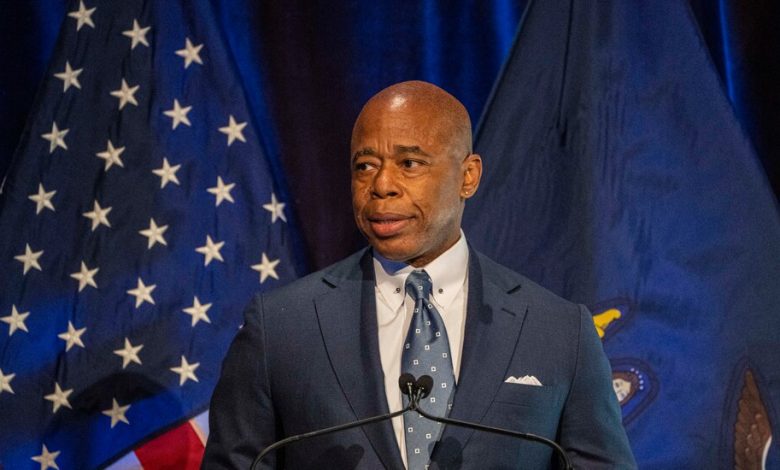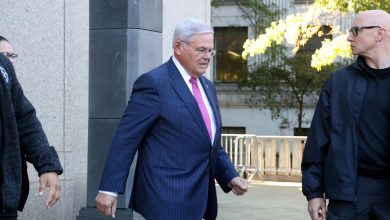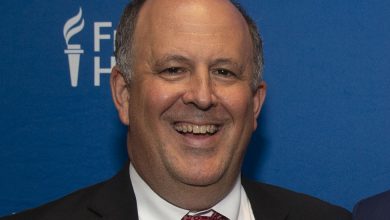Adams Unveils $103 Billion Budget as New York Faces Major Challenges

Facing an uncertain economy, Mayor Eric Adams on Thursday proposed a nearly $103 billion budget that reflected a long list of looming challenges for New York City, from multibillion-dollar deficits to the accumulating costs of thousands of migrants continuing to enter the city.
For the first time in at least a decade, the mayor has proposed cutting the budget from the current year’s adjusted spending plan — by roughly $5 billion, according to an analysis by the Citizens Budget Commission.
Yet Mr. Adams intends to maintain funding for what he said were his primary concerns: safety, housing and sanitation, a category that includes his battle against rats.
“As our city continues its recovery, our administration continues to make investments in our core priorities — including public safety, affordable housing and clean streets — while exercising strong fiscal management,” Mr. Adams said.
Despite efforts to restrain spending, the city is still predicting substantial deficits in the coming years. The drop-off in this year’s spending proposal is largely due to the waning of federal pandemic aid, the budget commission said. City funding declined less.
Budget experts say those deficits do not account for the substantial upcoming costs of settling the city’s municipal labor contracts and recurring costs from the thousands of migrants moving to New York City.
The city does not “yet have enough reserves to navigate us through a recession,” said Brad Lander, the New York City comptroller, in a statement. “Key areas remain underbudgeted, including police overtime, housing vouchers and likely increases in labor costs.”
Nearly three years into the pandemic, the city’s economy is still struggling to recover. Its unemployment rate exceeds the national average, with the arts and entertainment, food and hospitality sectors continuing to trail their prepandemic highs. The city’s homeless population is at record levels. Commercial landlords, who pay a sizable chunk of the city’s tax revenue, are still struggling to fill office buildings.
Late last year, Mr. Adams ordered city agencies to cut city-funded expenses by 3 percent for the current fiscal year and 4.75 percent for the following year. City Council leaders have criticized those cuts, particularly those to libraries and preschool programs for 3-year-olds.
Library leaders have warned that the mayor’s budget would cost libraries $20 million next year and could lead to painful reductions in hours and programming.
It was hard to immediately discern how Mr. Adams’s spending plan would affect city services; Justin Brannan, the chair of the Council’s committee on finance, described the proposed budget as so lacking in detail as to be “skeletal.”
Still, Council leaders fear the worst. The Council speaker, Adrienne Adams, said in an interview this week that the Council had a “different vision for our city” from the mayor.
“We will not allow our city to be damaged by the undermining of city agencies and services that meet the essential needs of all New Yorkers,” she said in a statement with Mr. Brannan on Thursday. “We are committed to delivering for New Yorkers, and we are prepared to fight to realize our vision in this year’s budget.”
Thomas P. DiNapoli, the state comptroller, faulted the mayor on Thursday for failing to anticipate recurring migrant-related costs in his budget documents.
“The city must lay out these and other risks transparently so that it may continue to plan and identify new ways to close these gaps without harming services, which would be counterproductive to the city, and state’s, economic recovery,” Mr. DiNapoli said.
Mr. Adams said on Thursday that the city’s revenue forecast includes an additional $1.7 billion this fiscal year, which ends in June, driven by “continued momentum from the record Wall Street activity in 2021.” But he acknowledged that the city was expected to see slowing growth in tax revenue over the next year.
“Although the economy has been strong, it’s slowing,” he said.
After his first year as mayor, Mr. Adams has argued that he is starting to make progress on public safety by reducing the number of shootings and murders. But major crimes surged 22 percent last year.
City officials said that funding for the Police Department would remain largely flat, and Mr. Adams defended his support for the agency, which typically has a $10 billion annual budget.
“I am not going to trade off public safety,” he told reporters, adding that New Yorkers “feel safe when they see that blue uniform.”
A staffing crisis in municipal government has slowed the work of critical agencies. The city continues to bleed personnel, with its current head count at 301,000, compared with 304,096 at the end of June, according to numbers provided by the Citizens Budget Commission.
Affordable housing production cannot keep up with demand or production levels of previous years, and the city has failed to meet its legally mandated bus- and bike-lane construction targets. The Human Resources Administration is struggling to process food stamp payments in a timely fashion, according to a recent report in City Limits.
Mr. Lander warned on Thursday that cuts to vacant city jobs could harm key services, and he said that the budget was not ambitious or focused.
“This budget meanders with little direction,” he said.
Despite criticism from City Council members, Mr. Adams said he wanted to work with Ms. Adams, the Council speaker, and called her a friend.
“She’s the co-pilot, and we have to land this plane,” he said. The mayor’s proposal is negotiated with the Council, which must pass a budget by June 30.
With limited money for new measures, Mr. Adams highlighted a few of his plans, including the expansion of a “rat reduction initiative” to Harlem at a cost of $1.8 million and $228 million for street reconstruction projects as part of the city’s efforts to reduce traffic fatalities.
Mr. Adams acknowledged on Thursday that critics would oppose his budget proposal and argued that he was trying to be responsible.
“As mayor, the buck stops with me,” he said. “It is my responsibly to keep our city on a stable path.”




